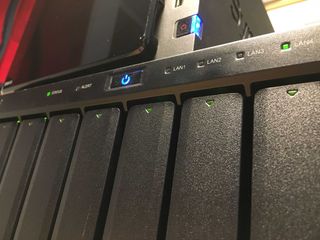What's a RAID array and why should I get one?

I know, all I hear is the ant queen from the commercials too. But we're not talking about that kind of Raid; we're talking RAID. It's been around since the 80s, and you may have heard it tossed around if you've spent any time around PCs, but what does it mean and why does it matter to you now?
Welcome to the RAID parade.
What is RAID?
RAID stands for Redundant Array of Inexpensive/independent Disks. It was created in 1988 as a means to combat the rising cost of disk drives. The creators argued that a line of inexpensive disks could outperform one expensive one. Basically, it's a row of hard drives (an array!) that join together to perform like one macdaddy hard drive. It's basically the Voltron of hard drives.
You'll often hear RAID as it relates to network attached storage or "NAS". You know in movies when you see the "mainframe" and it's rows and rows of hard drives backing up all of the evil corporation's information? That's NAS, and that's RAID in action.
There are several iterations of RAID that have been created to solve for different issues. Some are still in use, while others have been abandoned. The main ones you need to worry about are RAID 0, RAID 1, and RAID 5.
RAID 0
The first RAID created, RAID 0 is all about performance. It uses a technique called "striping," which breaks data up into pieces and written across multiple drives, which sort of makes it like one big drive. Where performance comes into play is that now, instead of having a one-lane highway for information, you have many, so the river widens and more water is able to flow through at once. Capisce? This is for professionals and those dealing with enormous files, and speeds are measured by the number of drives in the array, so if you've four drives, then it'll be four times faster. There is no redundancy, so it's not true RAID.
The only hitch in RAID 0's giddy-up is that if one drive fails, you lose it all. No Black Lion, no Voltron. You'll need at least two disks to take advantage of RAID 0.
Master your iPhone in minutes
iMore offers spot-on advice and guidance from our team of experts, with decades of Apple device experience to lean on. Learn more with iMore!
RAID 1
RAID 1 is what most beginners will likely use and get familiar with. Redundancy in its purest form, RAID 1 requires at least two disks, and data is then mirrored on each disk so that you essentially have multiple disks containing the exact same information. If one disk goes down, you have others to back it up, but it can be a little costly, since if you want 1TB of storage space, you have to buy two 1TB disks.
Write speeds also take a hit with RAID 1, since data is written to multiple disks simultaneously, so your speeds are only as good as your slowest drive. This is a great solution for redundancy, but you could have 10 drives in your setup and you'd still only get the storage space of 1 drive.
This solution is basically like an army of Storm Troopers. They're all the same, but their aim's only as good as the least accurate one (probably the dude who bonked his noggan).
RAID 2
RAID 2 isn't used anymore because it requires far too many disks for it to be practical. It stripes data in the same way as RAID 0, but it does it in smaller pieces. Basically, it's more trouble and expense than it's worth, so don't worry about it.
RAID 3
RAID 3 isn't really used on a consumer basis. It stripes data like RAID 0 and RAID 2, but at the byte level. You need at least three disks for it to work, and one disk is dedicated to data parity and error correction, so if a disk fails, you have something to back it all up (unlike RAID 0). RAID 3 is great for its high transfer speeds, but because all the drives work together simultaneously, it can only execute one read/write operation at a time.
RAID 4
RAID 4 is similar to RAID 3 on the striping and parity level, but data is striped at the block level, so it's broken up into bigger chunks, allowing each drive to be more independent. This allows for more than one read operation to happen at once, but since you still only have one disk for parity, you can only have one write operation going on at one time. Much like RAID 2 and 3, you won't see this much at the consumer level (so why are you even talking about it, Mike?!)(Because then you might be all like "0, 1, and 5? Where's 2, 3, and 4?" And I'd have to be like "Oh, those little guys? Don't worry about those little guys." And then there'd be no trust!).
RAID 5
Back to a setup that matters to you, RAID 5 is what you'll see the most when it comes to network attached storage (if it's not RAID 1). RAID 5 tries to marry performance and redundancy by striping data across all drives, while also spreading parity data across all drives. This means that writing parity data doesn't cause the same slowdown as it does in other RAID configurations.
You'll need at least three disks for this setup, and if one fails, your whole system won't go down with it, since parity data is on another disk. Think of it like Voldemort's Horcruxes. Powerful and if it dies, you can bring it back elsewhere.
RAID 6
RAID 6 is basically RAID 5, but it uses two disks for parity and correction. This way, if one cacks it during data recovery, the system can keep going with the other one. All this means is that the minimum drive requirement is upped to four.
Other configurations
As if everything above isn't complicated enough, you can also pair up configurations as "1+0" and "0+1". 0+1 is RAID 0 (where data is striped across multiple hard drives so that they act like one drive -- Voltron), mirrored as in RAID 1 for redundancy. 1+0 is the reverse: you're striping data across a set of mirrored drives.
Is RAID right for you?
Short answer: It's right for everyone. Basically, physical storage is becoming cheaper and cheaper as we go, so the startup cost for a RAID array is a lot lower than it was in the 80s. It's an excellent backup solution, and as more and more cloud storage services get hacked and their privacy becomes dubious at best, housing your own data is becoming increasingly prudent. You're also then avoiding the fees and signups and all that that comes with a cloud-based storage solution.
If you're a professional or hobbyist who works with a lot of large files, like HD video, music, or other design projects, then the speed and reliability of RAID is perfect for you. RAID 1 and 5 are the most popular, and you can buy their arrays in boxes, like those available from Western Digital. You really just have to decide if you want total redundancy and reliability with RAID 1 or a blend of performance and reliability with RAID 5. It all depends on your priorities.
If you're considering picking up the new iMac Pro, then a RAID array may be the perfect local storage and hard drive performance solution to all the pro-level shenanigans you're going to get into. Plus, you can't upgrade your iMac Pro's storage after the fact, and a RAID array is an increasingly inexpensive way to store large amounts of data, freeing up your iMac Pro's storage, unburdening its performance.
Best Thunderbolt RAID systems for iMac Pro
HBU?
Do you use a RAID array at home or in the office? Sound off in the comments below with your setup!
Mick is a staff writer who's as frugal as they come, so he always does extensive research (much to the exhaustion of his wife) before making a purchase. If it's not worth the price, Mick ain't buying.
Most Popular



